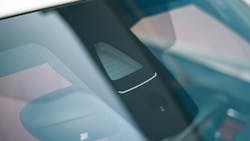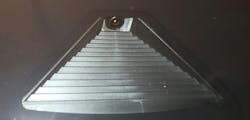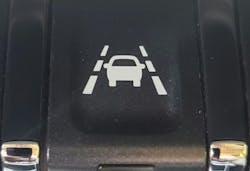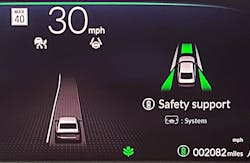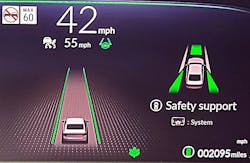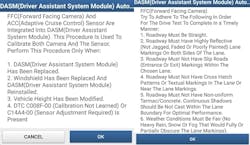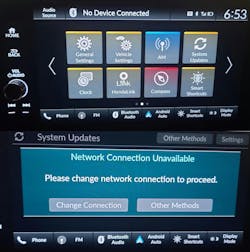As ADAS evolves, forward-facing cameras play a growing role
In recent years, the automotive industry has seen a significant transformation with the integration of advanced camera technologies. While rear-facing cameras have become a common feature to aid in reversing and parking, forward-facing cameras are now revolutionizing vehicle safety and functionality. These cameras, often referred to as dash cams, offer a plethora of benefits and have become a cornerstone in the development of Advanced Driver Assistance Systems (ADAS). These cameras enhance driving safety and convenience by providing real-time data that supports various functions such as adaptive cruise control, forward collision warning, and lane departure warnings. By continuously capturing high-resolution images and videos of the area in front of the vehicle, forward-facing cameras play a crucial role in making driving safer and more efficient.
Strategic Placement and Integration
A forward-facing camera system typically consists of two core components: the camera module and a processing unit. The camera module captures detailed images and videos, while the processing unit analyzes this visual data captured by the camera to identify objects, lane markings, pedestrians, and traffic signs. Additional sensors, such as radar (radio detection and ranging), or lidar (light detection and ranging), may work in conjunction with the forward-facing camera to enhance the accuracy and reliability of the system.
The forward-facing camera is usually mounted high in the center of the windshield near or integrated into the rearview mirror to provide a clear, unobstructed view of the road ahead. While most original equipment manufacturers (OEMs) use a single camera, some vehicles feature dual forward-facing cameras for enhanced functionality.
The real-time data captured by the camera is transmitted to the vehicle’s processing unit, which uses sophisticated algorithms and even artificial intelligence to interpret the camera's information. The vehicle shares this processed information from the camera, which includes object detection, lane detection, and traffic sign recognition, with other vehicle modules. This processed data supports various ADAS features, allowing the vehicle to respond appropriately to different driving conditions. Whether it’s maintaining a safe following distance, displaying road sign information on the dash, warning of potential collisions, or helping the driver stay within lane markings, forward-facing cameras are essential for modern vehicle safety and automation systems.
The Evolution of Vehicle Cameras
Initially, vehicle safety systems included technologies such as rain-sensing wipers, intelligent headlamp control, and lane departure warning systems. However, the advent of forward-facing cameras has expanded the scope of safety and convenience features in modern vehicles. These cameras now support a variety of advanced functions, including:
- Lane Keep Assist System (LKAS)
- Adaptive Cruise Control (ACC)
- Forward Collision Warning (FCW)
- Traffic Sign Recognition (TSR)
- Pedestrian Detection
- Obstacle Identification
- Night Vision Assistance
- Automatic Emergency Braking (AEB)
The incorporation of these functions has necessitated the advancement of lens and sensor technology tailored specifically for automotive applications. Most forward-facing cameras will also include their own dedicated defrosting systems to ensure the camera’s view is not obstructed by moisture on the windshield.
Collaboration with Radar/Lidar Systems
Forward-facing cameras often work in conjunction with radar or lidar systems to provide comprehensive safety features. In ACC systems, for example, the camera and long-range radar collaborate to detect and measure the distance to other vehicles, ensuring safe following distances and automatic speed adjustments. Similarly, with AEB systems, the camera supplements radar data to enhance detection accuracy and reduce false alarms, leading to more precise vehicle intervention.
Supporting Lane-Keeping and Traffic Sign Recognition
Beyond distance regulation, forward-facing cameras contribute to several other critical functions. They provide input to lane departure warning and lane-keeping systems, helping to prevent unintentional lane changes by issuing alerts and actively steering the vehicle back into its lane. These cameras can also recognize traffic signs, displaying relevant information on the instrument cluster and issuing warnings if speed limits are exceeded.
Automatic High-Beam Control
Forward-facing cameras are integral to automated high-beam lighting systems, which adjust the headlights based on the detection of other vehicles and ambient light levels. This ensures optimal visibility without blinding oncoming traffic, enhancing nighttime driving safety.
Calibration and Diagnostics
When removing, installing, or replacing a forward-facing camera, proper calibration is essential due to its high sensitivity. Calibration may also be required after events like airbag deployment or windshield replacement. Even altering the tire or wheel size may necessitate the recalibration of the forward-facing camera system. We can categorize the calibration process into two main types: static and dynamic, ensuring the camera is correctly oriented and functioning as intended.
Static Calibration: Performed while the vehicle is stationary, this method may involve manually aligning the camera using tools like bubble levels, angle/inclination meters, precise distance measurements, specialized camera targets and a fully capable scan tool. This procedure typically will require a large flat open area to perform the calibration.
Dynamic Calibration: Conducted while the vehicle is in motion, this method requires driving under specific conditions, such as maintaining a set speed on straight roads with clear lane markings. This process will involve a scan tool and may require two technicians for accuracy and safety. Weather conditions (rain, snow or fog), road curves, poorly defined lane markings, traffic or having to stop are just a few examples of issues that can impede or delay the completion of the dynamic calibration. The typical dynamic calibration drive time is under 10 minutes if conditions are optimal.
Diagnostics of all the forward-facing camera systems is going to involve the use of a scan tool. In some cases, a factory-level scan tool is going to be needed to diagnose and calibrate some systems. These forward-facing camera systems all generate DTCs, are heavily dependent on vehicle networks and often require complex alignment fixtures, and measurements to ensure their safety and functionality. Many of these systems will have software updates to fix bugs and issues and checking for software updates should be part of the diagnostic process before digging deep into a DTC diagnostic. It’s crucial to refer to vehicle-specific service information for diagnostics and to determine the exact calibration requirements, as procedures can vary significantly between OEMs and vehicle models.
Ford’s Lane Keeping System (LKS) Description and Calibration
The Ford Lane Keeping System (LKS) encompasses two primary functions: lane keeping aid and lane keeping alert. The LKS detects and tracks road lane markings using the camera in the IPMA (Image Processing Module A), ensuring that the vehicle stays within its lane. The lane keeping alert function notifies the driver of any inadvertent drifting towards the outside of the lane through steering wheel vibrations and a visual alert in the IPC (Instrument Panel Cluster) message center. Conversely, the LKS will automatically provide steering torque to help the driver maintain the vehicle within the lane.
If the vehicle is equipped with Adaptive Cruise Control (ACC) other features are added to the system using the IPMA: traffic sign recognition, lane centering and stop and go cruise control. ACC enables the vehicle to maintain a driver set distance between vehicles it approaches on the same path of travel. The Cruise Control Module (CCM) utilizes a radar beam to monitor the area in front of the vehicle and the IPMA and CCM share vital information on a dedicated private CAN network to enable the system. If the CCM’s radar beam is blocked by snow, ice, rain, or other debris the system will be disabled.
For the lane keeping alert and lane keeping aid to operate effectively, proper camera alignment is crucial. This calibration process is initiated using a capable scan tool and requires approximately 10 minutes of driving at speeds exceeding 40 mph (64 km/h) on a flat, straight road with clearly visible lane markings. It is important to avoid lane crossings, abrupt changes in vehicle speed, or excessive steering angle changes during the alignment process. During this calibration procedure the IPC will display the message “FRONT CAMERA MALFUNCTION — SERVICE REQUIRED.” Once the system has properly aligned and calibrated itself, the IPC will remove this warning message.
The IPMA camera alignment procedure should be performed after a windshield replacement, if tire size is changed, suspension or alignment work is completed and after the deployment of the front airbag.
GM’s Front View Camera Module Learn
If the windshield or the front view camera has been replaced, the vehicle's suspension modified (raised/lowered) or the camera module software was updated, the camera module must be recalibrated. The calibration process typically takes between three to five minutes.
For the calibration to be successful, the vehicle must be operated under specific conditions with a clean clear windshield until completion. A two-lane road with clear lane markings, well-defined curbs and a speed limit of at least 37 mph (60 km/h) is best for the procedure. Start the camera module learn by installing a capable scan tool and access the diagnostics menu for the front view camera module. Select configuration/reset function, and then select the front view camera learn procedure and follow the instructions provided on the scan tool screen to complete the calibration while driving. Avoid changing lanes and maintain a speed between 35-56 mph (56-90 km/h) during the procedure.
After completing the calibration process, manually activate the Collision/Detection Systems through the vehicle's infotainment system if necessary. Set the Forward Collision System to "Alert and Brake" to finalize the calibration. The amber indicator will turn off upon successful completion, and the green ready-to-assist light will illuminate shortly thereafter, indicating that the system is operational. Heavy traffic, stop and go traffic, curvy roads, poorly marked lanes, Botts dots, weather conditions, and exceeding 56 mph (90km/h) can all affect the length of time needed for the module to calibrate or even prevent it from calibrating all together.
GM has issued several TSBs and PITs in reference to their Front View Camera and DTCs that the system can generate. DTC B1008 SYM4B can typically be set if the front windshield has been replaced and is not properly installed. The gap between the top of the windshield and roof should be 3.6 mm (±1 mm).
FCA (Fiat Chrysler Automobiles)
FCA incorporates their Forward-Facing Camera (FFC) into the Drivers Assist System Module (DASM). The DASM combines a radar unit for object detection and an integrated camera into a single unit mounted near the rearview mirror. If the windshield is replaced, DASM module replaced or moved, or the tire diameter is changed, the DASM vertical alignment procedure must be performed first, using a vertical inclinometer and a scan tool. After that procedure is performed, then the FFC is calibrated.
Before starting the FCC calibration, make sure all tires are properly inflated, the vehicle is not loaded down, the windshield is clean, and the FCC's view is unobstructed. Then, using your scan tool proceed to the ADAS calibration menu, DASM auto alignment procedure and follow the scan tool's displayed instructions. The system will require the vehicle to be driven on a flat, straight road at a speed above 30 mph (48km/h) with clear lane markings, guard rails, utility poles, road signs and other common roadside objects. During the drive, maintain the required speed of 30 mph (dropping below 30 mph pauses the calibration) and avoid stopping to prevent restarting the process. FCA notes that weather conditions (snow, rain or fog), non-uniform pavement, or continuous shadows on the road can extend the alignment procedure. Typical calibration time is about seven minutes with ideal conditions. Once calibration reaches 100%, pull over safely and follow the prompts to complete the procedure by cycling the ignition. A final test drive on a road with clear lane markings will ensure the system operates correctly. Be cautious during this test, ensuring there is no oncoming traffic, and confirming that the vehicle maintains its lane as intended. Once verified, you can confidently return the vehicle to the customer knowing the system is working as designed.
Maintaining Camera Functionality
To ensure that the forward-facing camera functions optimally, regular maintenance is essential. This includes keeping the windshield clean and free of obstructions like cracks or chips, which can impair the camera’s view. Many vehicles are equipped with heating devices to remove condensation and ice from the camera’s field of view, preventing camera visibility issues.
In addition, repairs to the windshield near the camera’s field of view are often not recommended by OEMs to avoid compromising camera functionality. Using the correct windshield and following OEM procedures during installation are crucial for maintaining camera accuracy and performance.
A Note on Over-The-Air Updates, Including ADAS
In the rapidly evolving automotive industry, cars are increasingly becoming sophisticated computers on wheels. The integration of advanced technology in vehicles has reached a point where both software and hardware quickly become outdated. Automakers are addressing this challenge by introducing over-the-air (OTA) update capabilities, allowing them to keep vehicles up to date without requiring physical service visits. Tesla pioneered this approach, and now many legacy automakers like Honda, Ford, GM, and Volkswagen have followed suit, although not without facing some initial challenges. OTA updates have transformed car ownership, making it more akin to owning a smartphone, where updates and improvements can be seamlessly delivered over the air.
OTA updates in vehicles function similarly to the updates we receive on our smartphones, pushing notifications for new software installations and bug fixes. However, the scope of these updates extends beyond simple software fixes. They can enhance vehicle performance, safety, and user experience, all through a wireless internet connection. This capability eliminates the need for many service center visits, saving time and effort for car owners. While many of these updates are offered free of charge, especially those related to safety, the growing reliance on OTA updates is also opening up new revenue streams for automakers, with some updates and features being offered as paid upgrades. The automotive industry is increasingly adopting a subscription-based model, leveraging OTA updates to offer a range of services and features. HondaLink offers three different packages for example, ranging from $89 to $260 per year, depending on the services the customer wants to subscribe to.
There are two primary types of OTA updates: those for infotainment systems and those for vehicle performance and control. Infotainment updates enhance the user experience, addressing issues like laggy touchscreens and improving overall functionality. For instance, Volkswagen's ID.4 has seen improvements in its infotainment performance through OTA updates. On the other hand, performance and control updates can significantly alter a vehicle's capabilities, such as boosting acceleration or updating ADAS. However, these updates require robust security protocols to ensure safe implementation.
The benefits of OTA updates are evident in the improvements and fixes automakers have rolled out. Tesla, for example, offered an ‘acceleration boost’ for the Model Y, which reduced the 0-60 acceleration time, and it frequently updates its ‘full self-driving' feature. GM's Cadillac Escalade has received updates to its SuperCruise ADAS technology, while Ford's BlueCruise hands-free driving technology has also seen OTA enhancements. These updates demonstrate how OTA capabilities can extend a vehicle's lifespan and performance, ensuring it remains competitive without the need for physical modifications. However, it is important to note that only vehicles with the necessary electronic infrastructure can support OTA updates, making it impossible to retrofit older models with this capability.
While OTA updates offer many advantages, they also introduce potential security and privacy risks. Since these updates require a wireless internet connection, there is a risk of malware and data breaches. To mitigate these risks, it is advisable to accept OTA updates only when connected to a secure network, such as home Wi-Fi. As the automotive industry continues to embrace OTA technology, manufacturers are working to ensure robust security measures are in place. With manufacturers adopting OTA updates to provide a more customized and always changing driving experience, the future of automobile ownership is going to be more dynamic and involved.
However, as these updates become more prevalent, the line between car ownership and tech product usage continues to blur.
OTA Issues
There have been issues with OTA updates for certain 2021-2024 Buick, Cadillac, Chevy, and GMC vehicles. When a vehicle downloads a software update, the infotainment screen prompts the user to accept and install the update, provided the battery State of Charge (SOC) and Outside Ambient Temperature (OAT) requirements are met. Issues such as a no-crank condition due to a depleted battery, the radio remaining on after Retained Accessory Power (RAP) is canceled, and intermittent start-up messages indicating "Important Update … Download Resuming" have been reported. These problems can leave the OTA update hanging in a pending state or prevent it from being completed.
To address these issues, technicians are advised to reset the OTA update and clear the messages by charging the vehicle battery and ensuring the vehicle starts and runs properly. Technicians should verify the availability of an OTA system update in the Vehicle Settings, record the campaign number, and move the vehicle to a location with good cellular service. The vehicle must remain undisturbed for two hours with the battery SOC above 70% before confirming that no update messages are shown and there are no excessive parasitic battery draws.
Conclusion
The integration of forward-facing cameras in vehicles represents a significant leap forward in automotive safety and convenience. These cameras not only enhance traditional functions like adaptive cruise control and automatic emergency braking but also support a wide range of advanced features, from lane-keeping assistance to traffic sign recognition. As technology continues to evolve, forward-facing cameras will play an increasingly vital role in making driving safer and more efficient for everyone on the road. By understanding their functionality, calibration requirements, and maintenance needs, drivers and technicians can ensure these systems operate at their best, contributing to a safer driving experience for all.
About the Author

Jeff Taylor
Jeff Taylor is a seasoned professional at CARS Inc. in Oshawa with 40 years in the automotive industry. As a skilled technical writer and training developer, he holds licenses in both automotive and heavy-duty vehicle repair. Jeff excels in TAC support, technical training, troubleshooting, and shaping the future of automotive expertise.
